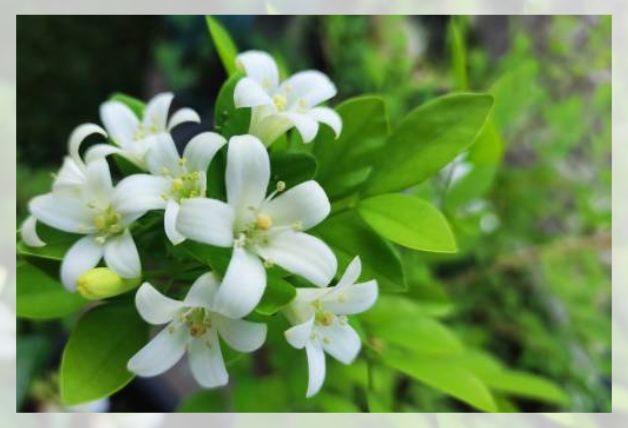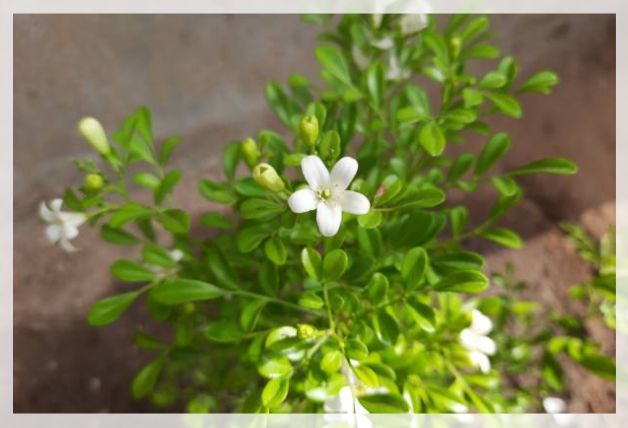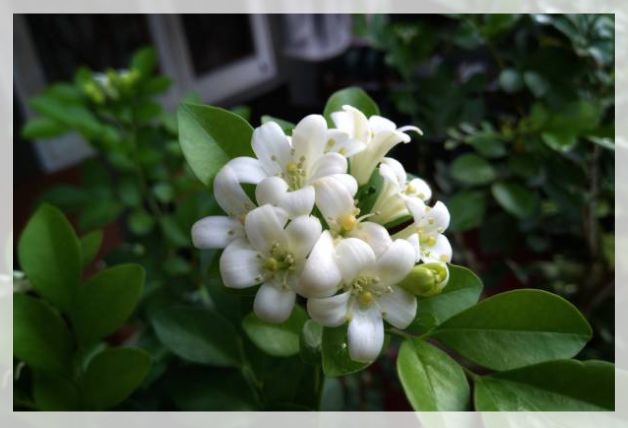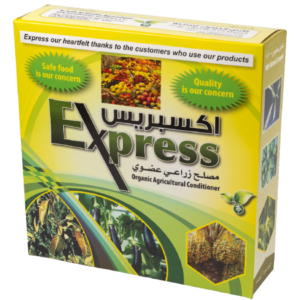Growing Orange Jasmine (Murraya paniculata) in Gulf Climates
Orange jasmine (Murraya paniculata) is a warm-climate evergreen shrub highly valued in Gulf-region gardens (UAE, Saudi Arabia, etc.) for its glossy green foliage, year-round white blooms, and intense citrusy fragrance. A low-maintenance garden plant adapted to desert conditions, it thrives with bright light, well-drained soil, and minimal fuss. Its clusters of sweet-smelling flowers attract bees, butterflies, and other pollinators, while the showy red-orange berries that follow appeal to birds. In short, orange jasmine is one of the most delightful fragrant flowering shrubs for UAE and Gulf gardens, adding both beauty and wildlife value:.
Quick Facts
| Common Name | Orange jasmine, orange jessamine, satinwood, mock orange |
|---|---|
| Botanical Name | Murraya paniculata (Chalcas paniculata) |
| Family | Rutaceae (citrus family) |
| Plant Type | Evergreen shrub |
| Mature Size | 8–12 ft tall and wide |
| Sun Exposure | Full sun to partial shade |
| Soil Type | Loamy, well-drained (avoids waterlogging) |
| Soil pH | Prefers moderately acidic to slightly alkaline (pH 6.6–7.5) |
| Bloom Time | Late spring through fall (and sporadically in winter in frost-free areas) |
| Flower Color | Pure white (highly fragrant) |
| Hardiness Zones | USDA 10–12 (sensitive to frost) |
| Native Range | Southeast Asia and Australia |
Pollinator and Wildlife Benefits
Murraya’s abundant, nectar-rich blooms make it a top pick for pollinator-friendly gardens. The pure-white, orange-blossom–scented flowers are so fragrant and prolific that “it is difficult to walk within 10 feet of this plant in flower and not notice the fragrance”. These blossoms attract honeybees, butterflies, and other beneficial insects. The subsequent bright red-orange berries provide food for birds, adding movement and color to the garden. By planting orange jasmine, Gulf gardeners create a mini-ecosystem: the plant feeds and shelters local wildlife, while the animals (pollinators) help ensure strong flowering and fruiting. This makes orange jasmine both beautiful and useful – a true boon for biodiversity in a desert landscape.

Light and Soil Requirements
Sunlight: Orange jasmine prefers bright light but does best with protection from the harshest midday sun. In Gulf climates, plant it where it will receive strong morning sun and afternoon shade. Filtered or dappled sunlight all day also works well. Avoid scorching late-afternoon sun during summer; a spot near a light shade or under a tree canopy is ideal.
Soil: This shrub needs well-drained soil – it dislikes “sitting” in wet, clayey ground. A loamy mix that is rich in organic matter will give the best results. If your desert garden has heavy sand or clay, amend it generously with compost, coco coir, or bark mulch to improve texture and moisture retention. Orange jasmine tolerates a range of pH from mildly acidic to mildly alkaline. Most native garden soils in the Gulf tend to be quite alkaline (pH above 7). If a soil test shows pH above 7.5, you can gently acidify the soil by adding sulfur, peat moss, or acidic compost. Conversely, plants will still do well if pH is slightly high – just avoid very basic ground. Our guides on acidic soil and alkaline soil cover amendments in more detail. In summary, mix rich organic matter into your planting hole and ensure good drainagefor best growth.
Watering and Climate Care
Watering: Though drought-tolerant once established, young orange jasmine plants need consistent moisture. Water deeply whenever the top 2” of soil feel dry. As a rule of thumb, provide about 1 inch of water per week; in Gulf summers you may need to water more frequently (twice per week or use drip irrigation) to keep the rootball evenly moist. Avoid overwatering – allow excess water to drain freely to prevent root rot. For container plants, check daily in extreme heat and use self-watering pots or add clay pebbles to retain some moisture.
Temperature and Humidity: Orange jasmine is tropical in origin and loves warmth. It thrives in the high temperatures common in Gulf summers and prefers warm nights (no cooler than about 40°F/4°C). This plant is not frost-tolerant, so in northern Gulf areas or colder winters, growers often plant it in pots to move indoors if needed. In UAE/Saudi winters (USDA zone 11), it will stay green year-round outdoors, as frosts are rare. Gulf humidity can be low, but Murraya adapts – it does best with moderate humidity (>50%) but will tolerate dry air. Indoors, mist the foliage or use a humidity tray if the air is very dry. In summary, keep the plant warm and protected from cold snaps, and avoid letting roots freeze.
Fertilizer: Feed orange jasmine regularly during the growing season (spring through fall). Use an all-purpose balanced fertilizer or an evergreen plant food every 3–4 weeks. A high-phosphorus bloom booster in spring can encourage flowers. Be careful not to overdo nitrogen – excess nitrogen (e.g. from high-nitrogen lawn clippings or fertilizer) can lead to lush foliage but few flowers. Follow product instructions; typically, a slow-release granular or diluted water-soluble fertilizer applied monthly will keep the plant vigorous. Pause fertilizing in winter when growth slows.
Potting and Repotting in Gulf Gardens
Orange jasmine grows well in containers, which is useful for Gulf gardeners who may wish to move the plant to avoid extreme conditions. When potting, choose a container at least 10–12 inches in diameter for a mature shrub, with good drainage holes. Light-colored pots or shaded locations can help prevent root overheating on hot patios. Use a premium potting mix enriched with compost and sand or perlite to ensure both fertility and drainage.
Repotting: Repot in spring as needed when the plant becomes root-bound. The roots of orange jasmine are somewhat delicate, so water the plant thoroughly a day before repotting to minimize stress. Gently remove the root ball and prune off no more than 1/4 of the old roots or broken roots. Place the plant in a slightly larger pot (2–4 inches wider) and backfill with fresh potting mix. Firm the soil and water well. Repotting refreshes the nutrients and gives room for new growth. In winter, if the plant is in a container below USDA zone 10, bring it indoors and reduce watering, keeping it in a bright spot until spring.

Propagation Methods
From Stem Cuttings
Propagating Murraya paniculata by cuttings is straightforward and yields plants identical to the parent. The best time is in spring or early summer. Follow these steps:
- Select a healthy, semi-woody stem and cut a 4–6 inch section just below a leaf node. Make sure the cutting has several sets of leaves and no flowers.
- Remove the leaves from the lower half of the cutting, leaving a few leaf pairs at the top.
- Dip the cut end into rooting hormone powder or gel (auxin hormone) to encourage root growth.
- Fill a small pot with a sterile, well-draining mix (peat/perlite or coco coir mix). Moisten the mix thoroughly.
- Plant the cutting about 1–2 inches deep, firming the soil around it.
- Place the pot in a warm, bright location out of direct sun (a shaded patio or under a tree). Maintain high humidity by covering with a plastic bag or using a propagator, and keep the soil lightly moist (not soggy).
- Roots typically form in 2–4 weeks; you can tug gently on the cutting – resistance indicates new roots. Once rooted, gradually acclimate it to normal conditions and then pot on into a larger container or plant in the garden. New plants grow quickly from this point.
This step-by-step approach, with the use of rooting hormone, maximizes success.
From Seed
Growing orange jasmine from seed is possible but slower and more variable. If you have fresh berries, you can try the following method:
- Extract the seeds from ripe berries and soak them in water for 2–3 hours.
- Fill a seed tray or pot with a sterile seed-starting mix. Lay the seeds on the surface and gently press them in. Do not cover them with soil, as they need light to germinate.
- Keep the mix evenly moist (not waterlogged) and maintain a warm temperature (~82°F/28°C) by placing them in a warm room or using bottom heat.
- Provide bright, indirect light. Germination can take 4–6 weeks.
- Once seedlings are a few inches tall with a couple of true leaves, transplant them into individual pots with well-drained potting soil.
Because seeds may take longer to sprout and are not widely available, many gardeners prefer cuttings. But if you have seeds on hand, this method will produce new plants over time
Seasonal Care in Gulf Climates
Spring
Spring is the prime growing season. New foliage flushes in early spring, followed by the first heavy bloom. To support flowering, clean up any debris around the plant, and apply fertilizer (especially a bloom-boosting formula with phosphorus) at the start of spring. Prune lightly after the first bloom to shape the shrub and remove any weak or crowded stems. This encourages a second round of blooms.
Summer
Summer heat in the Gulf can be extreme. Provide afternoon shade for young plants to prevent leaf scorch. Keep the soil consistently moist (mulch around the base to conserve moisture) and watch for signs of heat stress. If leaves begin to brown at the edges, move container plants to a cooler location. Cut back watering slightly in very high humidity to avoid fungal issues, but never allow the plant to wilt. Do not fertilize during the hottest months to prevent salt buildup; reserve feeding for early fall.
Autumn/Fall
Fall (September–November) often brings a second flowering flush. Continue to water and maintain soil moisture as temperatures moderate. Feed the plant with a balanced fertilizer early in fall to encourage another round of flowers. In late fall, you may stop fertilizing as growth slows. Remove fallen leaves and debris to reduce pests and diseases. In most Gulf areas, plants remain outdoors year-round; only move potted plants indoors if nighttime temperatures will approach freezing (near 32°F/0°C).
Winter
In Gulf winters (temperatures rarely below 50°F/10°C in UAE/Saudi Arabia), orange jasmine typically keeps its foliage and may flower lightly in warm spells. If a rare cold snap threatens (as in some desert areas), protect the plant by covering it or bringing it indoors. Indoors, give it a bright window and maintain moderate humidity. Water sparingly in winter (only when the soil dries to 2–3 inches deep) since growth is minimal. Prune any winter-damaged branches in early spring. Note that indoor plants may bloom less profusely due to lower light, but they still reward with occasional fragrant blooms.
Indoor vs. Outdoor Growing
Orange jasmine can be grown both outdoors and as a container houseplant. Outdoors, it enjoys full benefit of sunlight and will bloom abundantly if the climate is warm enough year-round (USDA zone 11+). In the Gulf, many gardeners grow it outside or on shaded patios. When grown indoors, place it in the brightest location possible (a south- or west-facing window). Maintain evening temperatures around 60–65°F for best flowering. Indoor air conditioning can dry the leaves; mist regularly or use a humidity tray. Whether indoors or out, the plant needs ample light to flower – without it, the plant may become leggy or bloom poorly. For Murraya paniculata care in a desert climate, the key is warmth, adequate light, and protection from extremes (heat or cold).

Pest and Disease Management
Orange jasmine is generally trouble-free, but in Gulf gardens keep an eye out for sap-sucking pests. Common problems include scale insects, whiteflies, mealybugs, and spider mites. These pests excrete honeydew, which can lead to sooty mold on leaves. As a first defense, wash pests off with a strong jet of water or wipe leaves with a mild soap spray.
For organic control, neem oil is highly effective. Neem oil or horticultural oil sprays smother soft-bodied insects like whiteflies, aphids, and scale. Apply in the early morning or evening (to avoid burning foliage in sunlight) and repeat every 7–14 days as needed. Neem is safe for beneficial insects, pets, and humans, and it actually preserves pollinators like bees and butterflies. In fact, beneficial predators such as ladybugs and lacewing larvae will eat many citrus pests naturally, so avoid broad-spectrum insecticides that can harm them.
If you spot scale on stems or leaves, scrape it off or prune infested parts. For severe infestations, a systemic insecticide may be considered as a last resort. Always encourage good air circulation to prevent fungal diseases, and don’t let water sit on leaves (to avoid sooty mold or mildew). Overall, cultural care (clean soil, proper watering) and organic sprays are sufficient for most pest control in Gulf gardens.
Pruning Tips
Regular pruning keeps orange jasmine neat and encourages bushy growth and flowering. Prune lightly after main flowering flushes (spring and fall) to remove dead or crossing branches. Avoid removing more than ⅓ of the plant at once to prevent shock. When young, you can shape it into a small tree or hedge by pruning lateral branches. As a general rule, remove any branch that is dead, damaged, or crowding the center. Proper pruning “promotes plant health” by allowing air and light into the interior. For detailed techniques, see our pruning tips guide. With time, regular pruning will maintain a compact, attractive form and ensure more flowers and new shoots each season.
Summary
Murraya paniculata (orange jasmine) is an excellent choice for gardeners in the UAE, Saudi Arabia, and other Gulf regions. Its fragrant blooms, glossy foliage, and tolerance of heat make it perfect for low-maintenance, fragrant gardens in hot climates. By planting it in rich, well-draining soil with proper sun, watering, and occasional feeding, you can enjoy this beautiful shrub year-round. With the tips above – from soil preparation to pest control – even novice gardeners can learn how to grow orange jasmine successfully in desert climate conditions. Follow these guidelines to create a thriving orange jasmine that will reward you with sweet aromas and vibrant life in your Gulf garden.






Leave a Reply